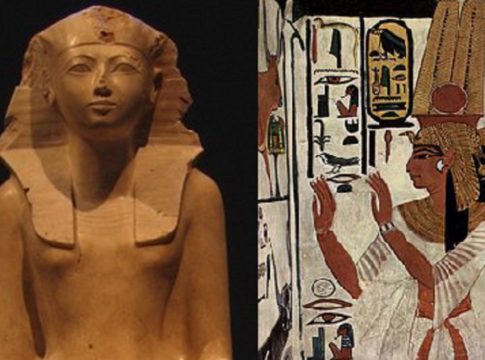In celebration of women’s international day last week, Sawy cultural wheel held a lecture for the Egyptologist Ahmed Sedik, on Saturday March 10th about women in Pharaonic era.
The lecture discussed the significant role that the Pharaonic woman played during this distinctive historical period; the role of the woman was never less important comparing to the role of the man. She had an equal role in the society and she was powerful enough to rule the country during various dynasties.
Sedik points out that “the Pharaonic woman had so much power to the extent that the names of some men during the Pharaonic age were inscribed on their tombs using the name of their mothers;” Sedik gave the example of “The son of Abana”; whose mother name was Abana; “most probably his mother had a respectable status, so he was named after his mother’s name,” said Sedik.
Ahmed Sedik tackled in his lecture three significant female Pharaonic figures, who ruled Egypt during the golden era of ancient Egypt.
Nitocris:
“History remembers Mamelukes massacre that Mohamed Aly Pasha, did during his ruling period in Egypt; however the history does not quite remembers that an Egyptian powerful Pharaonic woman did something very similar to Mohamed Aly massacre!”, noted Sedik. This woman is called Nitocris.
According to research Nitocris was only mentioned in Herodotus’ Histories and in writings by Manetho, an Egyptian priest during the Ptolemaic era. It has been claimed that she has been the last pharaoh of ancient Egypt’s Sixth Dynasty; Nitocris was the sister of Merenre Nemtyemsaf II who was a ruler of Egypt during the sixth dynasty.
Sedik explains “upon the death of her bother, Merenre Nemtyemsaf II, who has been put to death by his subjects, the powerful woman Nitocris, decided to take revenge for her bother. According to Herodotus, after she was placed upon the throne, she constructed a spacious underground chamber and, on pretense of inaugurating it, threw a banquet, inviting all those whom she knew to have been responsible for the murder of her brother. Suddenly as they were feasting, she let the river in upon them by means of a large, secret duct.”
Manetho, claims she built the “third pyramid” at Giza, which is attributed by modern historians and archaeologists to pharaoh Menkaure of the Fourth dynasty.
Hatshepsut:
Another powerful ruler that Sedik tackled in his lecture is Queen Hatshepsut, who was the fifth pharaoh of the Eighteenth Dynasty of Egypt.
She is generally regarded by Egyptologists as one of the most successful pharaohs of Egyptian dynasties. According to Egyptologist James Henry Breasted she is also known as “the first great woman in history of whom we are informed.”
Hatshepsut came to the throne of Egypt in 1478 BC. Officially, she ruled jointly with Thutmose the third, who had ascended to the throne the previous year as a child of about two years old. Hatshepsut was the chief wife of Thutmose the second.
Sedik talked about the “the power of this ruler who was able to establish the trading expeditions to Land of Punt. The beautiful Queen oversaw the preparations and funding for a mission to the Land of Punt/ Somalia, which was the trading partner of Egypt at that time and was known for producing and exporting gold, aromatic resins, blackwood, ebony, ivory.
According to researchers this trading expedition to Punt was roughly during Hatshepsut’s ninth year of reign. It set out in her name with five ships, accommodating 210 men that included sailors and 30 rowers. Hatshepsut’s delegation returned from Punt bearing 31 live myrrh trees, the roots of which were carefully kept in baskets for the duration of the voyage. This was the first recorded attempt to transplant foreign trees Egyptians also returned with a number of other gifts from Punt, among which was frankincense. Hatshepsut would grind the charred frankincense into kohl eyeliner. This is the first recorded use of the resin.
During his lecture Sedik talked about “the beauty and the uniqueness of the masterpiece Mortuary Temple complex of Hatshepsut at Deir el-Bahri in Luxor”. Sedik explains, “This unique complex was built by a 18th dynasty ancient Egyptian architect and government official, named Senenmut. He was able to built such a unique and vast complex that is considered one of the most beautiful complex of all Egyptian dynasties. His tomb was found in the Tombs of the Nobles near the temple at Deir el-Bahri. It was claimed that he was in love with the beautiful Queen,” says Ahmed Sedik.
Nefertari:
Her name means the beautiful companion. “ She was the wife of the pharaoh Ramses the Great”, says Sedik.”
Sedik explains that “Ramses the great was deeply in love with his Queen; his poetic statements about his wife certainly indicated his deep love; her presence is obvious in Abu Simbel great temple, her statue appears beside the colossal statues of Ramses II. As for the small temple at Abu Simbel it was dedicated to Nefertari and Hathor of Ibshek”, explains Sedik.
About her tomb, Sedik says “ that is certainly one of the most beautiful tombs of all dynasties; it is lavishly decorated, mostly with colored drawings; it is found at the valley of the Queens, however its status is a bit fragile,” explains Sedik.
According to researchers Nefertari was highly educated and able to both read and write hieroglyphs, which was a very rare skill at the time. She used these skills in her diplomatic work, corresponding with other prominent royals of the time.


